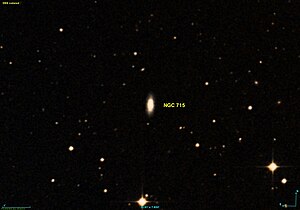NGC 715
| Galaxy NGC 715 |
|
|---|---|

|
|
| AladinLite | |
| Constellation | whale |
|
Position equinox : J2000.0 , epoch : J2000.0 |
|
| Right ascension | 01 h 53 m 12.5 s |
| declination | -12 ° 52 ′ 22 ″ |
| Appearance | |
| Morphological type | Sb / HII |
| Brightness (visual) | 14 likes |
| Brightness (B-band) | 14.8 mag |
| Angular expansion | 0.8 ′ × 0.4 ′ |
| Position angle | 175 ° |
| Surface brightness | 12.6 mag / arcmin² |
| Physical data | |
| Redshift | 0.018646 ± 0.000057 |
| Radial velocity | 5590 ± 17 km / s |
|
Stroke distance v rad / H 0 |
(250 ± 18) x 10 6 ly (76.6 ± 5.4) Mpc |
| history | |
| discovery | Ormond Stone |
| Discovery date | December 12, 1885 |
| Catalog names | |
| NGC 715 • PGC 6991 • MCG -02-05-069 • IRAS F01507-1307 • 2MASX J01531252-1252221 • GALEX ASC J015312.40-125222.3 | |
NGC 715 is a spiral galaxy with extensive star formation regions of the Hubble type Sb in the constellation Whale south of the ecliptic . It is estimated to be 250 million light-years from the Milky Way and about 60,000 light-years across.
In the same area of the sky is u. a. the galaxy NGC 720 and IC 169 .
The object was discovered on December 12, 1885 by the American astronomer Ormond Stone .
Web links
- SIMBAD Astronomical Database
- Auke Slotegraaf: NGC 715. Deep Sky Observer's Companion, accessed on November 5, 2015 .
